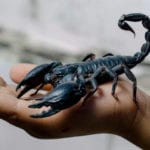 Mysteries
Mysteries  Mysteries
Mysteries  Creepy
Creepy 10 Scary Tales from the Middle Ages That’ll Keep You up at Night
 Humans
Humans 10 One-of-a-kind People the World Said Goodbye to in July 2024
 Movies and TV
Movies and TV 10 Holiday Movies Released at Odd Times of the Year
 Politics
Politics 10 Countries Where Religion and Politics Are Inseparable
 Weird Stuff
Weird Stuff 10 Freaky Times When Famous Body Parts Were Stolen
 Miscellaneous
Miscellaneous 10 Interesting Things Manufacturers Stopped Making and Why
 Gaming
Gaming 10 Funny Tutorials in Games
 History
History 10 Fascinating Little-Known Events in Mexican History
 Facts
Facts 10 Things You May Not Know about the Statue of Liberty
 Mysteries
Mysteries 10 Devastating Missing Child Cases That Remain Unsolved
 Creepy
Creepy 10 Scary Tales from the Middle Ages That’ll Keep You up at Night
 Humans
Humans 10 One-of-a-kind People the World Said Goodbye to in July 2024
Who's Behind Listverse?

Jamie Frater
Head Editor
Jamie founded Listverse due to an insatiable desire to share fascinating, obscure, and bizarre facts. He has been a guest speaker on numerous national radio and television stations and is a five time published author.
More About Us Movies and TV
Movies and TV 10 Holiday Movies Released at Odd Times of the Year
 Politics
Politics 10 Countries Where Religion and Politics Are Inseparable
 Weird Stuff
Weird Stuff 10 Freaky Times When Famous Body Parts Were Stolen
 Miscellaneous
Miscellaneous 10 Interesting Things Manufacturers Stopped Making and Why
 Gaming
Gaming 10 Funny Tutorials in Games
 History
History 10 Fascinating Little-Known Events in Mexican History
 Facts
Facts 10 Things You May Not Know about the Statue of Liberty
10 Strange Ways Migrations Might Surprise You
Migrations are not limited to a herd of wildebeest or zebras galloping across the African plains. Scientists are still stumped by things that are not supposed to migrate intelligently—like sand dunes and moss balls.
Human interactions with animal migrations can also have unexpected results. From eagles that bankrupted a Russian study with text messages to reindeer that stopped a popular TV show, here are ten bizarre facts about migration.
10 Animals with Zero Survival Instincts
10 Some Migrations Eat Bones
The unlucky winner of this scenario is the endangered European eel. Every year, these fish tackle an epic 3,000-mile-long (5,000-kilometer) journey that takes them across the Atlantic Ocean to their spawning grounds in the Sargasso Sea.
During this months-long trip, they develop from youngsters to adults. This is an energy-consuming transformation, so one might think they would snack on everything they see. On the contrary, migrating European eels refuse to eat.
Instead, their skeletons break down to release the minerals and nutrients that they need, and this keeps the fish going. Incredibly, by the time the eels reach the Sargasso Sea, they’ve lost over 50% of their skull volume and 65% of their spines. This makes them the only other species, apart from humans, to undergo bone loss during their lifetime.[1]
9 The 70-Mile Radar Blob
Weather scientists are familiar with flocks of birds causing a blip on their radar screens. But in 2017, a city-sized smudge drifted onto the monitor of the National Weather Service’s Boulder office in Colorado. At first, the puzzled meteorologists thought it was a bumper bird population heading into Denver, spanning a magnificent 70 miles (110 kilometers).
But something was wrong. The “flock” was moving north to south, an inexplicable move for any bird species in October. When the researchers took to Twitter to ask for help identifying the birds, people on the ground quickly scouted out the swarm.
The blip turned out to be butterflies. Tons and tons of butterflies. This was rare in itself, as insects rarely have the numbers and coherent flight patterns to cause a radar signature. The species in question was the painted lady. As to why the migrating butterflies made a detour through Denver, well, that’s not really surprising. Colorado has been going all out to plant the right plants and flowers to turn the state into a butterfly magnet.[2]
8 When TV Stars Strike
In recent years, Norway has experienced a “slow TV” trend. Viewers watch the most boring, minute-by-minute play of burning logs, someone knitting, or every second of a 7-day train journey from Bergen to Oslo.
In 2017, one show became a hit. Over a million people tuned in to watch the annual reindeer migration from the north to the island of Kvaløya. The epic journey was expected to produce 168 hours of live footage and culminate with the herd’s dramatic swim across the Kvalsundet Strait.
At first, the reindeer played along and trotted dutifully along their migration route while the camera crew used snowmobiles and drones to keep up with the herd. However, one day, in a location so remote that the crew had to use flashing mirrors to communicate, the reindeer ground to a halt and refused to move another inch.
To avoid the 31-person crew from freezing in the frigid wilderness, the TV station decided to get the team out of there and film the animals when they arrived for their big swim, which was estimated to happen a few days off schedule.[3]
7 Project Lights Out Philly
Every spring and fall, Philidelphia sees millions of migrating birds pass through the city. Unfortunately, the majority of these flights happen at night when artificial lights often cause the birds to become disorientated and smash into windows or walls. In 2020, statistics showed that as many as 1,500 birds died in a three-block radius in downtown Philidelphia on a single night.
This partially contributed to the birth of a new project in 2021. Called “Lights Out Philly,” the initiative encouraged prominent skyscrapers to turn their lights off at night. It was voluntary, but big names like Liberty Place, BNY Mellon Center, the Comcast towers, and 12 others agreed to go dark. Not only will the project save countless birds every migration season, but it will also reduce Philadelphia’s carbon emissions and save energy.[4]
6 A Human Migrated with Swans
True story. In 2016, when thousands of endangered Bewick’s swans left their breeding grounds in Russia for England, a biologist called Sacha Dench decided to migrate with them. She wanted to document their flight and find out why so many failed to survive the 4,500-mile (7,240-kilometer) trip every year. Using a motorized paraglider, she set off with the birds from the remote Nenets region inside the Arctic Circle.
The remarkable winter journey lasted three months. During this time, Dench zipped through ten European countries with the swans before touching down in the west of England.
While Dench was the main researcher, she wasn’t alone. Apart from a 2-person support crew that followed in a microlight aircraft, a team of scientists on the ground also assisted, and hundreds of volunteers along the swans’ migration route provided sightings and information about the birds.
Dench, who aptly earned the nickname “the human swan,” confirmed that the decline of the rare birds was mostly down to human interference. More specifically, the main culprits were illegal hunting and turning wetlands into farms.[5]
5 A Mysterious Tree Migration
This is (unfortunately) not an Ent situation where trees pull up their roots and walk away from their old territory. But tree populations can migrate when saplings grow in a new, more favorable direction and the older population dies out. Forest ecologists predicted that climate change would cause tree species in the eastern United States to move north toward the pole. But the trees had other ideas.
For some reason, forests are now heading west. Over a span of 30 years, nearly three-quarters of all tree species in the east have moved west at a mind-boggling rate of 9.5 miles (15.4 kilometers) per decade.
Even the experts are stumped. Studies show that climate change can only account for a fraction of this bizarre migration. Something else is going on. A number of factors might contribute, including new pests, how humans use the land, and even conservation projects. But right now, the truer driver behind the great American tree migration remains a mystery.[6]
4 Turkey Stopped an Ibis Migration
In the good old days, Northern bald ibises existed across Europe, and they could migrate as they pleased. But in 2016, Turkey decided that one flock was going nowhere. It’s not as bad as it sounds. Turkish conservation officials made the potentially species-saving decision when they realized that many of the birds migrating from their country to Syria never returned.
It’s not hard to imagine why. The highly dangerous civil war in Syria probably killed most of the missing ibises. But here’s the thing. The species is no longer abundant and is now considered critically endangered. Something had to be done to give the birds a shot at survival.
The flock in question lives at a breeding center in Birecik. Previously, they were allowed to migrate, but after many failed to return four years in a row, the remaining 200 were locked up at the sanctuary. The center will only release them if peace comes to the Middle East, and even then, the plan is to permanently keep some of the adults to ensure that the flock stays intact.[7]
3 Migrating Eagles Caused a Bankruptcy
A few years ago, Russian scientists decided to track migrating steppe eagles. The hope was that by understanding their flight patterns, the endangered birds could be better protected.
A team of ornithologists tagged 13 eagles with GPS-GSM trackers. These devices relied on GPS satellites to track and record the birds’ movements. This information was then stored in their internal memory. Once an eagle flew into an area with mobile network coverage, the stored data was automatically texted to the research team. The scientists were given a modest budget because, under normal circumstances, each message would cost a couple of cents.
However, some of the eagles flew so far into other countries that the global roaming costs ballooned almost 25 times. Worse, some eagles stayed away from areas with coverage for a long time. When these information hoarders finally approached a tower, the scientists got bombarded by hundreds of dollars worth of texts every day. The study was soon bankrupt.
When the public heard the news, there were some laughs. But sympathetic donors also crowdsourced over $5,000 to cover the costs and keep the project going.[8]
2 The Moss Ball Mystery
In parts of Alaska and Iceland, there are soft-ball-sized clumps of moss called “glacier mice.” Their odd name is not the mystery, though. These moss balls migrate. In herds. The usual suspects that might move them along, like the wind, the sun, or slopes, have all been eliminated as a means of propulsion.
However, these green globes don’t just roll around willy-nilly. Nope. Studies have shown that all the members of a glacier mice colony move in sync. Each ball rolls about an inch (2.5 centimeters) each day in the same direction at the same speed. They can even uniformly change speeds and directions. Researchers agree that this cannot be random movements, but the elusive force that drives them remains a mystery.[9]
1 Sand Dunes Hold Conversations
In the past, scientists viewed sand dunes as independently moving structures that sometimes collide and consume each other. However, recent studies revealed a different truth. Migrating sand dunes communicate with each other to avoid collisions.
During a test, a rotating water-filled channel was used to keep two underwater dunes moving in a circle for hours. Dunes of the same size (or slightly different sizes) always did the same thing. First, the leading dune would speed up and mysteriously repel the other into slowing down. After traveling 180 degrees to the opposite side of the ring-shaped channel, the leading dune slowed down. At this point, the back dune sped up a little. The pair then balanced out their speeds until they traveled an even distance apart at the same pace.
Researchers are sure that the same principles apply to land dunes. But whether dunes shift along a desert or the ocean floor, nobody has a clue how they are communicating with each other.[10]








